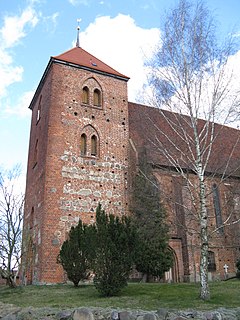John III, Lord of Werle (nicknamed John van Ruoden; born: before 1300; died: between 1 April and 28 August 1352) was Lord of Werle-Goldberg from 1316 until his death. He was the son of Nicholas II and Rixa of Denmark.
Nicholas II, Lord of Werle was Lord of Werle-Parchim from 1283 until his death, and from 1292 Lord of Werle.
After the death of his father, Nicholas II, in 1316, it was decided to divide Werle. John III. took control over the part Werle-Goldberg and his uncle John II took over Werle-Güstrow. John III built himself a castle in Goldberg. King Christopher II of Denmark promised John and Lord Henry II of Mecklenburg on 4 May 1326 that he would invest them with Rügen. However, he had earlier promised the principality to Pomerania. This led to a war, the Rügen War of Succession. Under the Peace of Brudersdorf, Pomerania was allowed to keep Rügen, but had to pay Mecklenburg 31000silver marks in compensation.
John II, Lord of Werle[-Güstrow] nicknamed The Bald, was from 1309 to 1316 co-regent of Werle and from 1316 to 1337 Lord of Werle-Güstrow. He was the second eldest son of John I of Werle and Sophie of Lindow-Ruppin.

Goldberg is a town in the Ludwigslust-Parchim district, in Mecklenburg-Western Pomerania, Germany. It is situated 24 km northeast of Parchim, and 46 km east of Schwerin.

Christopher II was king of Denmark from 1320 to 1326 and again from 1329 until his death. He was a younger son of Eric V. His name is connected with national disaster, as his rule ended in an almost total dissolution of the Danish state.
From 1350, he left the business of government to his son and co-ruler Nicholas IV. On 1 April 1352, he was already terminally ill. He died later that year. He was probably buried in Malchow Abbey.
Nicholas IV, Lord of Werle[-Goldberg], nicknamed Poogenoge was from 1350 to 1354 to Lord of Werle-Goldberg.

Malchow Abbey is a former Cistercian nunnery in Malchow in the district of Mecklenburgische Seenplatte in Mecklenburg-Vorpommern, Germany. The monastic buildings are on the east shore of the Malchower See and now accommodate the Mecklenburgisches Orgelmuseum.
This page is based on this
Wikipedia article Text is available under the
CC BY-SA 4.0 license; additional terms may apply.
Images, videos and audio are available under their respective licenses.
The House of Griffin or Griffin dynasty was a dynasty ruling the Duchy of Pomerania from the 12th century until 1637. The name "Griffins" was used by the dynasty after the 15th century and had been taken from the ducal coat of arms. Duke Wartislaw I was the first historical ruler of the Duchy of Pomerania and the founder of the Griffin dynasty. The most prominent Griffin was Eric of Pomerania, who became king of the Kalmar Union in 1397, thus ruling Denmark, Sweden and Norway. The last Griffin duke of Pomerania was Bogislaw XIV, who died during the Thirty Years' War, which led to the division of Pomerania between Brandenburg-Prussia and Sweden. Duchess Anna von Croy, daughter of Duke Bogislaw XIII and the last Griffin, died in 1660.

Werle was a fiefdom in the Holy Roman Empire that was founded in 1235. In German it is known as a Herrschaft or Fürstentum (principality). It was created in the partition of territories in Mecklenburg that followed the death of Henry Borwin II of Mecklenburg.

Barnim I the Good from the Griffin dynasty was a Duke of Pomerania from 1220 until his death.
Henry I was a Prince of Mecklenburg-Werle and Mecklenburg-Güstrow.
The County of Gützkow was a part of the Duchy of Pomerania during the High Middle Ages (1219–1359), named after the central town of Gützkow and stretching roughly from the Peene River in the South to the Ryck River in the North. It emerged from the earlier Liutician Principality of Gützkow, that was turned into a castellany when subdued by the Dukes of Pomerania. When the last Count of Gützkow died in 1359, the area was turned into a Vogtei, which was merged into Amt Wolgast in the beginning 16th century.

Wartislaw IV or Vartislav IV was Duke of Pomerania-Wolgast from 1309 until his death. He was the only son of Duke Bogislaw IV of Pomerania and his wife Margareta, a daughter of Vitslav II, Prince of Rügen. Vartislaw IV had four sisters: Jutta, Elisabeth, Margareta and Eufemia.
Henry III, Duke of Mecklenburg was Duke of Mecklenburg from 1379 until his death.
John I, Duke of Mecklenburg-Stargard, Duke of Mecklenburg from 1344 to 1352 and Duke of Mecklenburg-Stargard from 1352 to 1392.
Henry II, Lord of Mecklenburg, nicknamed the Lion was regent of Mecklenburg from 1287 to 1298, co-regent from 1298 to 1302 and ruled alone again from 1302 to 1329.
Lord Nicholas V of Werle [-Goldberg and -Waren] was Lord of Werle-Goldberg and Werle-Waren from 1385 until 1408. He was the son of John VI of Werle and Agnes, the daughter of Nicholas IV of Werle-Goldberg.
Henry, Duke of Mecklenburg-Stargard was the ruling Duke of Mecklenburg-Stargard, including the Lordships of Neubrandenburg, Stargard, Strelitz and Wesenberg, from 1417 to 1466. He is sometimes called "Henry the Elder" to distinguish him from Duke Henry IV of Mecklenburg.
John IV of Werle-Goldberg, was from 1354 until his death Lord of Werle-Goldberg.
Nicholas I, Lord of Werle, was Lord of Rostock from 1229 to 1234 and Lord of Werle from 1234 until his death.
Vitslav II, variously called Vislav, Vizlav, Wislaw, Wizlaw and Witslaw in English sources was a prince of Rügen.
Nicholas, Lord of Rostock, nicknamed the child was a member of the House of Mecklenburg. He was co-ruler of Rostock from 1282 to 1284, and the sole ruler from 1284 to 1312.
The Wars of the Rügen Succession were two early 14th century conflicts fought primarily between Mecklenburg and Pomerania for control of the Danish Principality of Rügen on the southern Baltic Sea coast.






